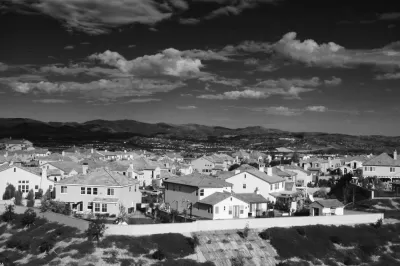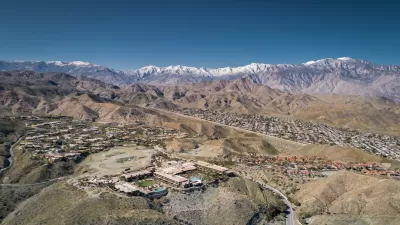It's been a while since 2008, and a new crop of homeowners is colonizing the far-flung exurbs. Mostly foreclosed and even abandoned last time around, the exurbs are still a risky buy.

Written off (sometimes literally) after the Great Recession, the exurbs are back. Buyers' motives are largely the same: extreme prices and scarce options closer to the urban core. The situation is particularly outlandish in the Bay Area: "Buying was impossible: The median price is almost $1 million. In Mountain House, about 55 miles east in the San Joaquin Valley, [homes sell for] for less than half that."
Thankfully, the commuters of the exurban diaspora featured in this article can take the train to work. "If we had to drive we wouldn't last," one of them remarked.
Without viable housing options closer in, young people with families often consider settling down far, far away. "The push to the outskirts is being fueled by the more than 4 million new jobs created since 2013, historically low mortgage rates and a population bulge of millennials settling down."
With 2008 in mind, experts doubt whether that decision could ever be wise. "The exurbs' comeback is precarious because they're attractive to buyers who 'could be more sensitive to mortgage-rate increases,' said Megan McGrath, an analyst with MKM Holdings. 'The longer-term risk is that it's a more vulnerable land position to hold ahead of the next housing downturn.'"
FULL STORY: Dead U.S. Exurbs Are Staging Comebacks

Montreal Mall to Become 6,000 Housing Units
Place Versailles will be transformed into a mixed-use complex over the next 25 years.

Planetizen Federal Action Tracker
A weekly monitor of how Trump’s orders and actions are impacting planners and planning in America.

DARTSpace Platform Streamlines Dallas TOD Application Process
The Dallas transit agency hopes a shorter permitting timeline will boost transit-oriented development around rail stations.

Study: 4% of Truckers Lack a Valid Commercial License
Over 56% of inspected trucks had other violations.

Chicago Judge Orders Thousands of Accessible Ped Signals
Only 3% of the city's crossing signals are currently accessible to blind pedestrians.

Philadelphia Swaps Car Lanes for Bikeways in Unanimous Vote
The project will transform one of the handful of streets responsible for 80% of the city’s major crashes.
Urban Design for Planners 1: Software Tools
This six-course series explores essential urban design concepts using open source software and equips planners with the tools they need to participate fully in the urban design process.
Planning for Universal Design
Learn the tools for implementing Universal Design in planning regulations.
City of Mt Shasta
City of Camden Redevelopment Agency
City of Astoria
Transportation Research & Education Center (TREC) at Portland State University
US High Speed Rail Association
City of Camden Redevelopment Agency
Municipality of Princeton (NJ)




























